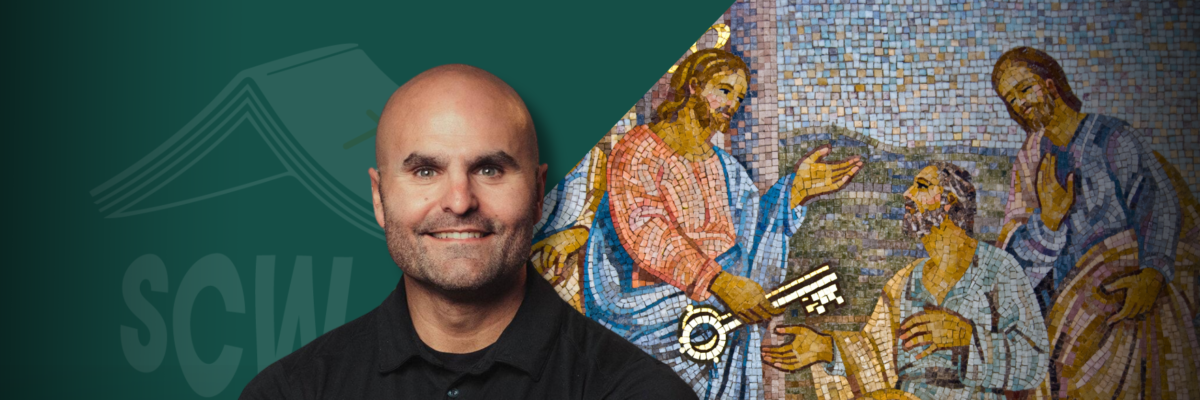
Episode 125: Year C
In today’s episode, we highlight several details that are relevant for apologetics in the readings for this upcoming Palm Sunday, Year C. Many of the details, which are found in the Gospel reading for the procession of palms—Luke 19:28-40, and the second reading, taken from Philippians 2:6-11, we’ve already covered in previous episodes. So, our discussion of these details will be brief. The two details that we will mainly focus on come from the Gospel reading, which is taken from Luke 22:14—23:56. The apologetical topics that these details relate to are the Real Presence of Jesus in the Eucharist and Peter’s Role as the First Pope.
Readings: Click Here
Looking for Sunday Catholic Word Merchandise? Look no further! Click Here
Hey everyone,
Welcome to The Sunday Catholic Word, a podcast where we reflect on the upcoming Sunday Mass readings and pick out the details that are relevant for explaining and defending our Catholic faith.
I’m Dr. Karlo Broussard, staff apologist and speaker for Catholic Answers, and the host for this podcast.
In today’s episode, we’re going to highlight several details that are relevant for apologetics in the readings for this upcoming Palm Sunday, Year C. Many of the details, which are found in the Gospel reading for the procession of palms—Luke 19:28-40, and the second reading, taken from Philippians 2:6-11, we’ve already covered in previous episodes. So, our discussion of these details will be brief. The two details that we will mainly focus on come from the Gospel reading, which is taken from Luke 22:14—23:56. The apologetical topics that these details relate to are the Real Presence of Jesus in the Eucharist and Peter’s Role as the First Pope.
Let’s briefly review the details from the Gospel reading for the procession with palms. First, there is the issue of the tethered colt. Notice Luke only speaks of a colt that the apostles untie and bring to Jesus. Yet, in Matthew 21:2, Matthew records that there was a donkey and a colt. Some skeptics charge the Gospel writers as contradicting each other.
But, as I pointed out in episode 19 for Palm Sunday, Year A, there is no contradiction here. For there to be a contradiction, Luke would have had to deny there being two donkeys, saying something like, “there was only one donkey.” Affirming that the disciples took the colt doesn’t entail there was only one. It’s simply an intention to focus on one detail and omitting another—in this case, that there was another donkey.
The omission of certain details is something that’s called descriptive approximation. Ancient authors were selective with their material and had to choose the things they wanted to include or not include. Some authors included extra details and others streamlined things. Luke streamlines the details about the donkeys whereas Matthew includes both.
The other issue, which is related to the first, is Jesus riding the colt. Luke writes, “So they brought it to Jesus, threw their cloaks over the colt, and helped Jesus to mount.” But Matthew tells us, in 21:7, that Jesus mounted both the ass and the colt. It would seem there is a contradiction between Luke and Matthew.
But, like for the previous issue, there is no contradiction. For there to be a contradiction Luke would have had to say something like, “Jesus only rode on the colt.” Affirming that Jesus rode on the colt doesn’t entail that He did not ride on the colt’s mother. But Luke doesn’t deny that Jesus rode on the colt’s mother. He simply omits this detail. Therefore, there is no contradiction.
The other details that we’ve already covered relates to Jesus’ Messianic kingship. As we explained in episode 70 for Palm Sunday, Year B, that Jesus rides on a donkey evokes Zechariah’s prophecy in Zechariah 9:9-12, which speaks of the Messianic king riding a donkey as he brings deliverance and restoration to the people of Israel.
Furthermore, the crowd’s acclamation, “Blessed is the king who comes in the name of the Lord,” calls to mind the enthronement song for the King’s procession into Jerusalem and the Temple, which we find in Psalm 118:20-26. The application to Jesus is clear: they believe he is the Messianic King, the one who will bring them salvation. Although, the salvation will be from sin and death and not the Romans.
Okay, let’s now turn to the Gospel reading, which is taken from Luke 22:14—23:56. Obviously, there’s a lot here that we could pick out and talk about. However, I’m going to focus on two details that are relevant to apologetics. And both are fitting given that they are unique to Luke’s Gospel.
The first detail is Jesus’ statement about the “fruit of the vine.” Luke records Jesus saying,
Take this and share it among yourselves;
for I tell you that from this time on
I shall not drink of the fruit of the vine
until the kingdom of God comes.
Many Christians appeal to this statement of Jesus as recorded in Mark and Matthew’s version of the Last Supper as evidence against the Real Presence of Jesus’ blood in Mark and Matthew Jesus calls the contents of the chalice “the fruit of the vine” after the words of consecration.
But what this objection fails to consider is Luke’s version here. Luke puts the disputed words before the consecration:
And he took a cup, and when he had given thanks he said, “Take this, and divide it among yourselves; for I tell you that from now on I shall not drink of the fruit of the vine until the kingdom of God comes. . . . And likewise the cup after supper, saying, “This cup which is poured out for you is the New Covenant in my blood” (22:17-18, 20).
Given the ambiguity as to where the words actually were placed, Christians who deny the Real Presence can’t appeal to these words to show that the contents of the chalice post-consecration were merely wine since it just as well could have referred to the contents of the chalice before the words of consecration.
An appeal to chronological ambiguity is not our only response, however. Notice that it’s “a cup” that contains “the fruit of the vine,” which is a distinct cup from “the cup after supper” that Jesus says contains his blood. So, at least according to Luke, the cup that Jesus says contains the “fruit of the vine” is not the cup of consecration. You can’t appeal to “the fruit of the vine” saying of Jesus to undermine belief in the Real Presence when the cup that contains the “fruit of the vine” might not even be the cup that is believed to contain Jesus’ blood.
We can go even farther in our response: Luke’s version was probably the more accurate one.
There is evidence that Luke may have placed the “fruit of the vine” phrase before the words of consecration to clarify the sequence in Mark’s and Matthew’s account.
It was known in the first century that Mark did not write things in chronological order. A second-century Christian bishop named Papias records John the presbyter, an eyewitness of Jesus’ ministry, as saying, “Mark, having become an interpreter of Peter, wrote down accurately, though not in order, whatsoever he remembered of the things said or done by Christ.”[i] This quote was preserved by the fourth century church historian Eusebius of Caesarea in his Church History (3:39:14–15).
Now, Luke tells us explicitly in the prologue to his Gospel that he set out “to write an orderly account” of the things accomplished among them, even though many before him, such as Mark, had already compiled such a narrative (Luke 1:1-3).
Therefore, it’s reasonable to conclude that Luke diverts from Mark’s order because he is clarifying Mark’s placement of Jesus’ statement. If so, the Protestant challenge loses its force. But even if not, in Luke the order is reversed, weakening any argument based strictly on the order in Mark and Matthew.
Now, even if we can concede for argument’s sake that Jesus uses the “fruit of the vine” phrase after he says, “This is my blood,” it wouldn’t necessarily follow that he intended to attest that the substance was merely wine. That’s because biblical authors often described things according to their appearance. Scholars call this phenomenological language.
We use it even today. For example, the weatherman says the sun will “rise” at six A.M. and “set” at seven P.M. Should we conclude that the weatherman is an advocate of geocentrism, who believes that the sun moves up and down over the earth? Of course not! He’s simply describing something according to the way we see it.
In the Bible, angels and even God are described according to how they are revealed to the senses. The book of Genesis describes the Lord and his angels as men since that is the form they took when they conversed with Abraham (Gen. 18:2; cf. 18:10, 19:1). Tobit does the same thing with reference to an angel in Tobit 5:2-4.
These authors were not trying to say God and angels are actually men. They simply described phenomena in a common way as they were observed according to the senses.
Similarly, the Bible often refers to death as “sleep.” Take Job 3:11-13, for example: “Why did I not die at birth, come forth from the womb and expire? . . . For then I should have lain down and been quiet; I should have slept; then I should have been at rest.” Or John 11:11, where Jesus says, “Our friend Lazarus has fallen asleep, but I go to awake him out of sleep.” Or Paul in 1 Thessalonians 4:15, contrasting those “who are alive, [and] who are left until the coming of the Lord” with those “who have fallen asleep.”
A similar line of exegesis can be applied to Mark’s and Matthew’s record of Jesus’ words at the Last Supper. It’s perfectly reasonable for Jesus to employ the phenomenological language of “wine” even when referring to his precious blood, since that is how it appears to the senses. The mere reference to “the fruit of the vine,” therefore, doesn’t prove that the substance in the chalice is wine.
Here’s yet another response: it’s common for a biblical author to describe something according to its prior state. For example, Eve is called Adam’s bone (Gen. 2:23), and Aaron’s rod is said to have devoured the “rods” of the magicians even though they had become serpents (Exod. 7:12). This idiom of describing something according to its prior state could explain why Jesus describes his blood as wine. He could simply be referring to it according to what it once was. Paul does the same thing when he refers to the Eucharist as “bread” (1 Cor. 11:26), even though we know he believed it to be participation in the literal body of Christ (10:16).
Finally, we can acknowledge there is mystery. But that mystery doesn’t disprove the Real Presence. Jesus doesn’t point to the chalice and say, “The substance in here is not my blood.” The gist of his statement seems to be about not identifying the contents of the chalice, but to prophesy that he would not drink of the “fruit of the vine” until the coming of the kingdom.
What this means is something of a mystery—especially since his death was less than a day away.
Was he referring to the heavenly banquet (Isa. 25:6-8; Rev. 19:9)? It’s possible, given that Jesus describes heaven as a banquet: “I tell you, many will come from east and west and sit at table with Abraham, Isaac, and Jacob in the kingdom of heaven” (Matt. 8:11).
Was he referring to the sour wine he would partake of while hanging on the cross (John 19:30)? That’s also possible, since it’s the first time he drinks wine since his cryptic statement in the upper room.
Or it could refer to what St. John Chrysostom (c. 347-407) thought it referred to—Jesus’ drinking wine with his disciples after his Resurrection. For Chrysostom, Jesus’ talk about the kingdom refers to his resurrection. And Jesus’ talk about drinking wine “new” refers to drinking wine “after a new manner . . . no longer having a passible body, or needing food.”[ii] In any case, despite the mystery, the words “fruit of the vine” don’t disprove the Real Presence.
For more details on this subject, again, check out my book Meeting the Protestant Response.
The next detail is Jesus’ address to Peter at the Last Supper.
Simon, Simon, behold Satan has demanded to sift all of you like wheat, but I have prayed that your own faith may not fail; and once you have turned back, you must strengthen your brothers.
Catholics appeal to this verse to argue for Peter as the first pope. There are two clues that, when taken together, reveal Peter’s unique role as leader of the Church.
The first is Jesus’ prayer of protection. Jesus informs the apostles that Satan desires to sift all of them, which we know from the use of the Greek second person plural pronoun, humas. When Jesus speaks of his protection prayer in the next verse, however, the Greek text switches to second person singular, sou. Jesus thus singles out Peter when he makes the promise, “I have prayed for you [Greek, sou] that your faith may not fail.” Jesus then commands Peter, and only Peter to strengthen the brethren.
If Jesus intended all the apostles to be equal in their mission of leading his Church, with no kind of priority or prominence whatsoever, it’s hard to see why Jesus would have promised only Peter a special protection that’s connected to his unique command for Peter to strengthen the brethren. In fact, such words would be outright misleading. The Catholic view, therefore, comports best with this passage. Peter receives a special prayer of protection from Jesus because he’s the preeminent apostle who must strengthen the others.
Now, Jesus doesn’t intend Peter to strengthen the brethren like all Christians are generally called to strengthen each other. Rather, Jesus intends Peter to strengthen the brethren (the apostles) as their leader. And there are details in the context that support this, and this is what Luke is highlighting. The instruction to strengthen the brethren caps off a discourse about leadership and authority within the kingdom of God.
Luke begins by telling us that a dispute broke out among the disciples concerning “which of them was to be regarded as the greatest” (Luke 22:24). In response, Jesus contrasts worldly leadership with the leadership the apostles are to exercise: “The kings of the Gentiles exercise lordship over them; and those in authority over them are called benefactors. But not so with you; rather let the greatest among you become as the youngest, and the leader as one who serves” (Luke 22:25–26).
Jesus’ contrast with the royal authority of Gentile kings suggests that he intended the apostles to exercise authority as well—but differently than what the apostles were accustomed to. Catholic apologist Joe Heschmeyer points out, the word leader here is translated from the Greek hēgeomai, which is the same word Matthew uses for the “ruler [Greek, hēgoumenos] who will govern my people Israel” (Matt. 2:6). Luke also uses the word to describe Joseph as “governor [Greek, hēgoumenon] over Egypt” (Acts 7:10).
In Luke 22:29-30, Jesus makes explicit his intention that the apostles were to exercise royal authority: “As my Father appointed a kingdom for me, so do I appoint for you that you may eat and drink at my table in my kingdom, and sit on thrones judging the twelve tribes of Israel.” That the apostles are to judge reveals that their role is administrative and judicial.
So, up to this point we have the apostles arguing about who is the greatest. Jesus explains the general principle of servant leadership (Luke 22:25-26). He then assures the apostles that they all have a prominent place of authority in his kingdom (Luke 22:29-30). Immediately after this, Jesus makes the exclusive promise to pray for Peter as a response to Satan’s attempt to sift all the apostles like wheat and gives Peter the exclusive instruction to strengthen the brethren.
Notice how Jesus progressively moves from the general to the specific. When seen in this light, it becomes clear that Jesus intends Peter to be the leader among the apostles. But Peter is to be a servant leader and “strengthen the brethren” (v.32); not “exercise lordship over them” (v.25).
Peter’s service, therefore, is not merely preserving others from denying Christ like he did or helping them repent if they have fallen. Rather, his service is one of leadership among those who exercise administrative and judicial authority within Christ’s kingdom.
For more exegesis on this passage, and the variety of Protestant comebacks to this line of reasoning, check out my book Meeting the Protestant Response: How to Answer Common Comebacks to Catholic Arguments.
Conclusion
Well, my friends, that does it for this episode of the Sunday Catholic Word. The readings for this upcoming Palm Sunday, Year C provides us with lots of apologetical material:
- Details that give rise to conversations about the historical reliability of the Gospels,
- Details about Jesus’ Messiahship,
- Details that support Peter as the first pope, and
- Details that relate to the real presence of Jesus in the Eucharist.
As always, I want to thank you for subscribing to the podcast. And please be sure to tell your friends about it and invite them to subscribe as well through any podcast platform that they use. You can also access the archived episodes of the Sunday Catholic Word at sundaycatholicword.com.
You might also want to check out the other great podcasts in our Catholic Answers podcast network: Trent Horn’s The Counsel of Trent, Joe Heschmeyer’s Shameless Popery, Jimmy Akin’s The Jimmy Akin podcast, and Tim Staples “1 on 1 with Tim,” all of which can be found at catholic.com. And if you want to follow more of my own work, check out my website at karlobroussard.com
One last thing: if you’re interested in getting some cool mugs and stickers with my logo, “Mr. Sunday podcast,” go to shop.catholic.com.
I hope you have a blessed Palm Sunday, Year C. Until next time, God Bless.
[i] Eusebius, Church History 3:39:14–15; emphasis added.
[ii] Thomas Aquinas, Catena Aurea: Commentary on the Four Gospels, Collected out of the Works of the Fathers: St. Matthew, Vol. 1, ed. J. H. Newman (Oxford: John Henry Parker, 1841), 897.



